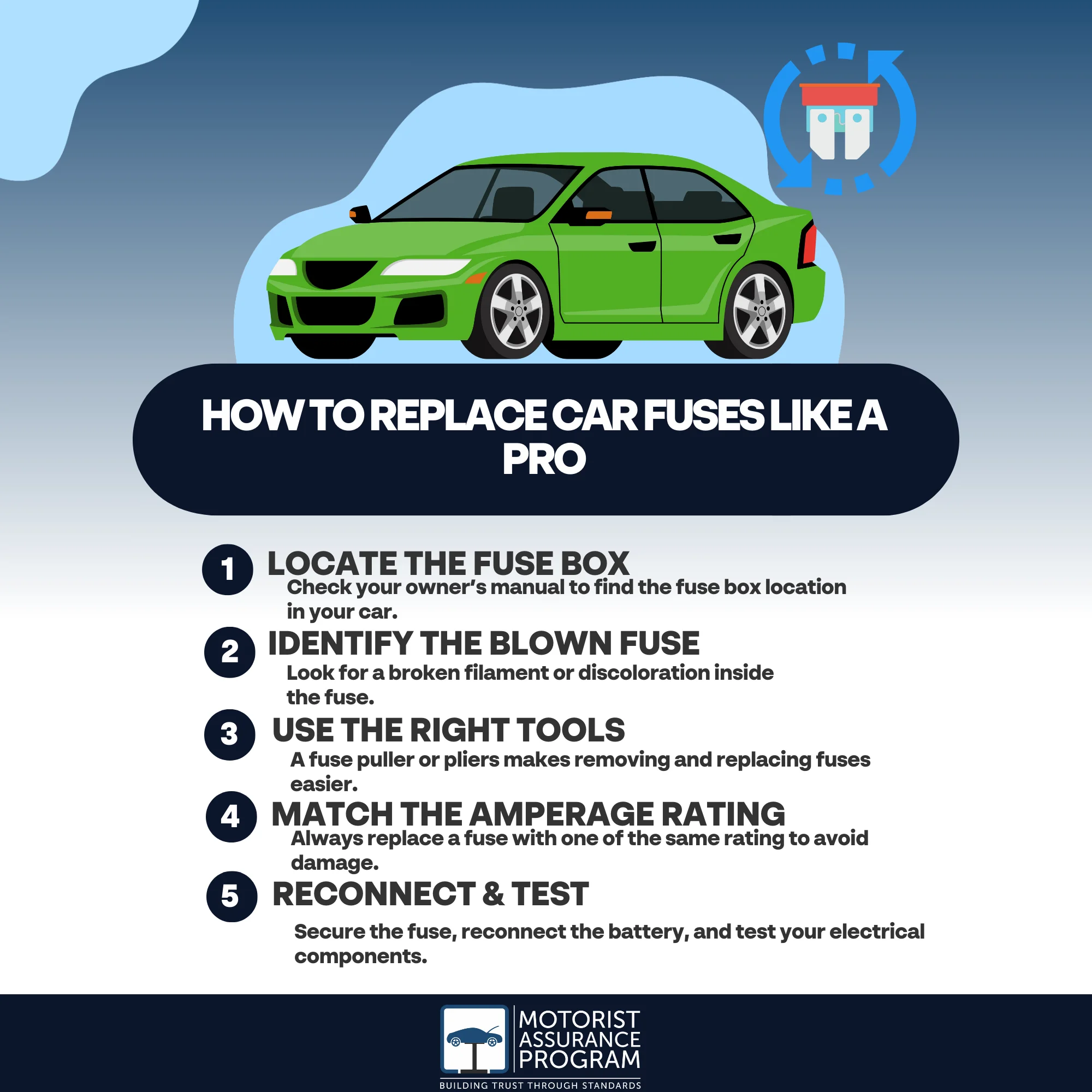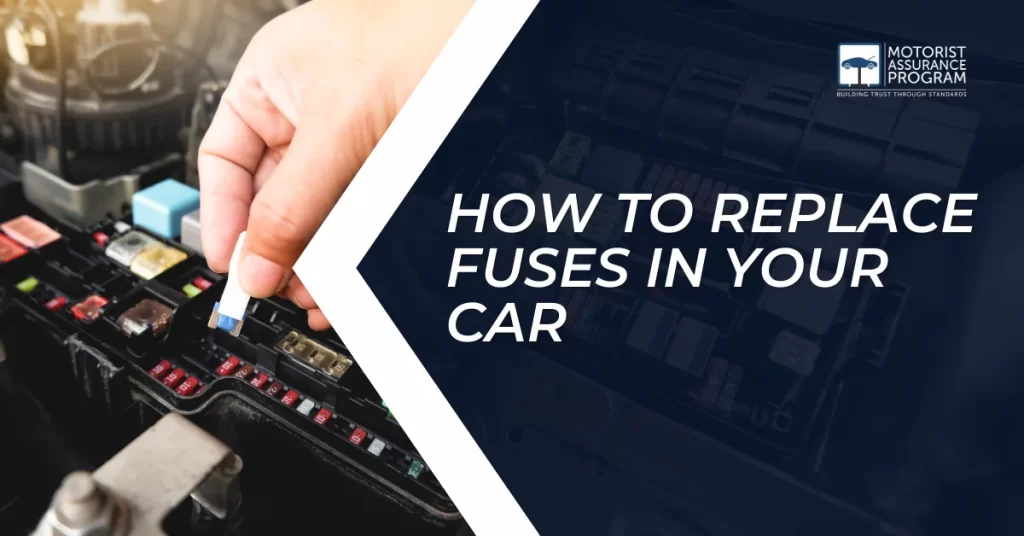Replacing fuses in your car is simple. First, turn off your vehicle and locate the fuse box using your owner’s manual. Check for any blown fuses by looking for a broken filament or discoloration. Use a fuse puller or pliers to remove the blown fuse and insert a new one that matches the amperage rating. Be sure everything’s connected properly before restoring power. If you want more tips and tricks for a smooth replacement, keep going!

Key Takeaways
- Gather necessary tools and ensure the vehicle is turned off before beginning the fuse replacement process.
- Consult the owner’s manual for the location and type of the blown fuse.
- Use needle-nose pliers or a fuse puller to carefully remove the blown fuse.
- Insert a new fuse that matches the amperage rating of the old one into the correct slot.
- Double-check all connections and secure the fuse box before restoring power to the electrical system.
Types of Car Fuses
When it comes to understanding car fuses, you’ll find a few different types that serve specific purposes in your vehicle’s electrical system. The most common types of car fuses include blade fuses, which are easy to replace and come in various amperages, and glass tube fuses, often found in older vehicles. Then, there are mini and low-profile fuses, designed for compact spaces. Each type is vital for protecting your vehicle’s electronic components. When you’re performing a fuse replacement car, it’s important to choose the correct type and size to guarantee proper function. Familiarizing yourself with these types can save you time and effort during maintenance, keeping your vehicle running smoothly and safely.
How to Identify a Blown Fuse
Identifying a blown fuse is essential to maintaining your vehicle’s electrical system. You’ll want to know how to check fuses in your car efficiently. Start by visually inspecting the fuse; a broken filament or discoloration indicates a problem. Here’s what to look for:
- Flickering lights or power loss
- Unusual smells or smoke
- Inoperative accessories (like radio or windows)
- Warning lights on the dashboard
These signs can help you determine when a fuse should be replaced. If you suspect a blown fuse, pull it out and inspect it closely. Don’t forget to check the fuse box diagram to guarantee you’re checking the right one. Keeping your electrical system in top shape is vital for your driving safety!
How to Replace a Car Fuse
Before you start replacing a fuse, it’s important to gather the right tools and make certain your vehicle is off. You’ll need to know how to handle both blade-style fuses and larger ones, as they require different approaches. Once you’ve swapped out the blown fuse, don’t forget to reconnect the battery cable to restore power.
1. Before Replacing a Fuse
Understanding the symptoms of a blown fuse can save you time and frustration before you start the replacement process. You need to know how to check car fuses and where the fuse is located to avoid unnecessary hassle. Here are some common signs that indicate a blown fuse:
- Your headlights flicker or go out completely.
- Power windows stop working suddenly.
- Dashboard warning lights illuminate unexpectedly.
- Radio or other electrical components fail to turn on.
Identifying these symptoms early can help you pinpoint the issue quickly. Make sure to consult your owner’s manual for specific locations of fuses and their functions. With the right knowledge, you’ll feel empowered and ready to tackle the task ahead!
2. Replacing Blade-Style Fuses
Once you’ve determined that a blown fuse is the culprit behind your electrical issues, replacing blade-style fuses is a straightforward task. First, locate the fuse box, usually found under the dashboard or in the engine compartment. Next, you’ll need to identify the blown fuse by checking the diagram on the fuse box cover. To learn how to remove car fuses, use a pair of needle-nose pliers or a fuse puller. Grip the fuse firmly and pull it straight out. Then, take your replacement fuse—make sure it matches the amperage—and insert it in the same slot. You might be wondering, “Can I replace a fuse myself?” Absolutely! It’s a simple DIY fix that can save you time and money.
3. Replacing Larger Blown Fuses
Replacing larger blown fuses can seem intimidating, but it doesn’t have to be. First, make certain you’ve got the right tools and replacement fuses. Check your owner’s manual for the specific location and type of the blown fuse. Once you find it, carefully pull it out using a fuse puller or pliers.
Here’s what to remember while replacing car fuses:
- Confirm your car is off before starting.
- Take note of the amperage rating on the old fuse.
- Insert the new fuse firmly into the slot.
- Double-check everything before turning the power back on.
4. Reconnect Battery Cable
After you’ve successfully replaced the blown fuse, it’s time to reconnect the battery cable. Start by ensuring the cable is clean and free of corrosion. Position it back onto the battery terminal, tightening it securely. This step is essential to restore power to your vehicle’s electrical system. If you’re unsure where to get a fuse replaced in your car, most auto parts stores can assist you. They often provide guidance on how to check car fuses with a test light, ensuring your new fuse is functioning properly. Once everything’s reconnected, check your electrical components to confirm they’re working as expected. Remember to keep an eye on your fuses; regular checks can prevent future issues.
Tips and Tricks for Replacing Car Fuses
While you might think replacing fuses is an intimidating task, it can be quite straightforward with a few handy tips. First off, you don’t necessarily have to ask, “Should I replace all the fuses in my car?” Just focus on the blown ones. Having the right tool to remove car fuses will make all the difference.
Here are some tips to keep in mind:
- Always check the fuse box diagram for proper identification.
- Wear safety gloves to avoid any sharp edges.
- Keep a few spare fuses on hand for emergencies.
- Double-check connections to guarantee everything’s secure.
With these tricks, you’ll find replacing fuses is less of a chore and more of a skill you’ll master!
Frequently Asked Questions
Can I Use a Regular Household Fuse in My Car?
You shouldn’t use a regular household fuse in your car. Automotive fuses are specifically designed for vehicle electrical systems, ensuring safety and proper function. Using the wrong type can lead to electrical issues or fires.
How Often Should I Check My Car Fuses?
You should check your car fuses regularly, ideally every few months, after any electrical issue or before long trips. Staying proactive keeps your vehicle running smoothly and prevents unexpected breakdowns from blown fuses.
What Causes Fuses to Blow Frequently?
Fuses frequently blow due to electrical overloads, short circuits, or faulty components. It’s important to check your wiring, guarantee your devices aren’t drawing too much power, and replace any damaged parts to prevent recurring issues.
Are There Different Fuse Ratings for Different Vehicles?
Just like fingerprints, each vehicle’s fuse ratings vary. It’s essential to check your owner’s manual or consult a professional, as using the wrong rating might lead to electrical issues or even damage your car.
Where Can I Buy Replacement Fuses for My Car?
You can buy replacement fuses for your car at auto parts stores, big retailers, or online marketplaces. Just make sure to check your vehicle’s manual for the correct fuse type and rating before purchasing.
Conclusion
Now that you know how to replace fuses in your car, you’re equipped to tackle those pesky electrical issues like a seasoned mechanic. Just remember, even the best cars can run into trouble—think of it like a modern-day Hercules facing his challenges. By understanding fuses, you’re not just fixing problems; you’re gaining the confidence to take control of your vehicle’s maintenance. So, the next time you encounter a problem, you’ll be prepared to meet the challenge.


